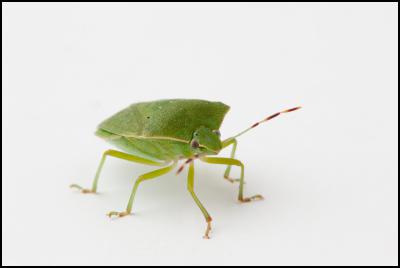Determining the origin of insect pests
Determining the origin of insect pests

Researchers in the Bio-Protection Research Centre at Lincoln University are developing a new way to reveal the birthplace of unwanted insect pests – information that is vital for managing pest incursions.
Despite stringent biosecurity measures, unwanted insects occasionally arrive in New Zealand from overseas in shipping containers and imported goods. If these pests breed and spread, they could have a huge impact on agriculture, horticulture, forestry and the environment.
Pinpointing the birthplace of an exotic insect pest is crucial for determining whether it is an isolated ‘hitchhiker’ or part of an established breeding population. This knowledge is helpful for biosecurity agencies, such as the Ministry for Primary Industries, to decide the best approach for dealing with an incursion.
Dr Peter Holder, a postdoctoral fellow at Lincoln University, is measuring the elemental composition of insect wings or body parts and using this signature to indicate the region where the insect was born. The signature is derived from the insect’s food source, which in turn reflects the rainfall and soil in its country of origin.
“The technique is very sensitive and compares the abundance of trace elements like arsenic and cadmium, coupled with the isotope ratios of hydrogen, lead and strontium in minute samples,” says Dr Holder. “The hydrogen isotope ratio of the wing tissue reflects the temperature, and hence latitude that the organism has developed, while the other markers give the geological age of the bedrock and soil of the place of development.”
This is the first test to accurately determine the geographic origin of a pest using climate and geological markers. “By combining two independent types of markers, this is a much more powerful test of insect provenance than any previously available,” says Dr Holder.
Dr Holder’s method has successfully determined the birthplace of specimens of the corn earworm moth, a worldwide agricultural pest found in New Zealand and Australia.
With funding from Better Border Biosecurity (B3) and the Australian Plant Biosecurity Cooperative Research Centre, Dr Holder is now applying his method to stink bugs and fruit flies, both highly significant insect pests that have recently been detected in New Zealand and could potentially establish themselves here.
The recent discovery of a single female yellow spotted stink bug by a gardener in Temuka, and detection of Queensland fruit flies in two separate incidents in Whangarei earlier this year, have highlighted the need for this technology. Dr Holder explains that the method needs to be tested and trialled for each group of insects, as the signature can be influenced by the way an insect feeds and how it absorbs the nutrients.
“The challenge is finding a method that will work consistently and reliably on the very small amounts of material that we can extract from a single insect. Especially when we start to look at much smaller species, like flies rather than moths,” says Dr Holder.
Dr Holder is mentored by Dr Karen Armstrong a leading Lincoln University researcher and research leader in the Better Border Biosecurity programme.
The research on the corn earworm moth is published in open-access journal PLOS ONE: http://www.plosone.org/article/info%3Adoi%2F10.1371%2Fjournal.pone.0092384
Ends


 Science Media Centre: Government Plans To Double Mineral Exports By 2035 – Expert Reaction
Science Media Centre: Government Plans To Double Mineral Exports By 2035 – Expert Reaction University of Canterbury: AI-powered Tool To Combat Rising Wildfire Danger
University of Canterbury: AI-powered Tool To Combat Rising Wildfire Danger NZ Certified Builders: BCITO And NZCB Announce Apprentice Challenge 2025
NZ Certified Builders: BCITO And NZCB Announce Apprentice Challenge 2025 NIWA: Seasonal Climate Outlook February To April 2025
NIWA: Seasonal Climate Outlook February To April 2025 Bill Bennett: Are New Zealand's Submarine Links Safe?
Bill Bennett: Are New Zealand's Submarine Links Safe? Bill Bennett: DeepSeek Shock Could Spur AI Space Race
Bill Bennett: DeepSeek Shock Could Spur AI Space Race



